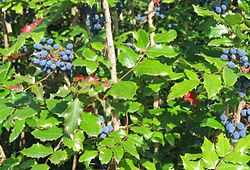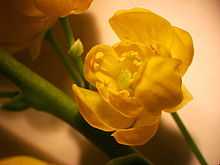Mahonia aquifolium
| Oregon grape | |
|---|---|
 | |
| Scientific classification | |
| Kingdom: | Plantae |
| (unranked): | Angiosperms |
| (unranked): | Eudicots |
| Order: | Ranunculales |
| Family: | Berberidaceae |
| Genus: | Mahonia |
| Species: | M. aquifolium |
| Binomial name | |
| Mahonia aquifolium (Pursh) Nutt. | |
| Synonyms[1][2][3] | |
| |
Mahonia aquifolium (Oregon-grape[4] or Oregon grape) is a species of flowering plant in the family Berberidaceae, native to western North America. It is an evergreen shrub growing to 1 m (3 ft) tall by 1.5 m (5 ft) wide, with pinnate leaves consisting of spiny leaflets, and dense clusters of yellow flowers in early spring, followed by dark bluish-black berries.[5]
Etymology
The specific epithet aquifolium means "holly-leaved", referring to the spiny foliage.[6] The common name is often (always in the UK) left un-hyphenated as Oregon grape, though doing so invites confusion with the true grapes. Some writers avoid this confusion by using "Oregon grape-holly", or "Oregon holly-grape" as a vernacular name for any species of mahonia. It also occasionally appears in print as Oregongrape. There are several common species of Oregon-grape, many with numerous cultivated varieties (cultivars). Among these are tall Oregon grape (Mahonia aquifolium); Cascade, low, dull, or dwarf Oregon grape (M. nervosa); and creeping Oregon grape (M. repens).
Description
M. aquifolium grows to 1–2 m (3 ft 3 in–6 ft 7 in) tall by 1.5 m (5 ft) wide, with pinnate leaves up to 30 cm (12 in) long, each leaf made up of spiny leaflets. The leathery leaves resemble holly and the stems and twigs have a thickened, corky appearance. The flowers, borne in dense clusters in late spring, are yellow, and are followed by spherical dark dusty blue berries, which give rise to the common name "Oregon grape".[7]
Taxonomy
Some authors place Mahonia in the barberry genus, Berberis. [8][9][10][11] The Oregon-grape is not related to true grapes, but gets its name from the purple clusters of berries whose color and slightly dusted appearance are reminiscent of grapes. .

Distribution
Mahonia aquifolium is a native plant in the North American West from Southeast Alaska to Northern California, and eastern Alberta to southern Colorado, often occurring in the understory of Douglas-fir forests (although other forest types contain the species) and in brushlands in the Cascades, Rockies, and northern Sierras.
In some areas outside its native range, M. aquifolium has been classified as an invasive exotic species that may displace native vegetation.[12][13]
Cultivation
M. aquifolium is a popular subject in shady or woodland plantings. It is valued for its striking foliage and flowers, which often appear before those of other shrubs. It is resistant to summer drought, tolerates poor soils, and does not create excessive leaf litter. Its berries attract birds.[5]
Numerous cultivars and hybrids have been developed, of which the following have gained the Royal Horticultural Society's Award of Garden Merit:-
- M. × wagneri 'Pinnacle'[14] (M. aquifolium × M. pinnata)
- 'Apollo'[15]
Other uses
The small purplish-black fruits, which are quite tart and contain large seeds, are included in smaller quantities in the traditional diets of Pacific Northwest aboriginal peoples, mixed with Salal or another sweeter fruit. Today they are sometimes used to make jelly, alone or mixed with salal.[16] Oregon grape juice can be fermented to make wine, similar to European barberry wine folk traditions, although it requires an unusually high amount of sugar.[17] The inner bark of the larger stems and roots of Oregon-grape yield a yellow dye; the berries give purple dye.[18] As the leaves of Oregon-grape are holly-like and resist wilting, the foliage is sometimes used by florists for greenery and a small gathering industry has been established in the Pacific Northwest.
Medicinal use
Some Plateau Indian tribes used Oregon-grape to treat dyspepsia.[19]
Certain extracts from Mahonia aquifolium may be useful in the treatment of inflammatory skin diseases such as eczema and psoriasis,[20][21][22] although side effects include rash and a burning sensation when applied.[20]
Recent studies indicate that M. aquifolium contains a specific multidrug resistance pump inhibitor (MDR inhibitor) named 5'-methoxyhydnocarpin (5'-MHC) which works to decrease bacterial resistance to berberine in vitro.[23]
Culture
Oregon grape is the state flower of Oregon.[24]
References
- ↑ Tropicos
- ↑ The Plant List
- ↑ Flora of North America vol 3
- ↑ "BSBI List 2007" (xls). Botanical Society of Britain and Ireland. Archived from the original on 2015-02-25. Retrieved 2014-10-17.
- ↑ 5.0 5.1 RHS A-Z encyclopedia of garden plants. United Kingdom: Dorling Kindersley. 2008. p. 1136. ISBN 1-4053-3296-4.
- ↑ Harrison, Lorraine (2012). RHS Latin for gardeners. United Kingdom: Mitchell Beazley. p. 224. ISBN 978-1-84533-731-5.
- ↑ Michael P. Williams (2012). "Berberis aquifolium, in Jepson Flora Project (eds.) Jepson eFlora". Retrieved 2013-08-08.
- ↑ Flora of North America, vol 3
- ↑ Loconte, H., & J. R. Estes. 1989. Phylogenetic systematics of Berberidaceae and Ranunculales (Magnoliidae). Systematic Botany 14:565-579.
- ↑ Marroquín, Jorge S., & Joseph E. Laferrière. 1997. Transfer of specific and infraspecific taxa from Mahonia to Berberis. Journal of the Arizona-Nevada Academy of Science 30(1):53-55.
- ↑ Laferrière, Joseph E. 1997. Transfer of specific and infraspecific taxa from Mahonia to Berberis. Bot. Zhurn. 82(9):96-99.
- ↑ North Carolina Botanical Garden / Conservation / Plants to Avoid in the Southeastern United States
- ↑ Plants to Avoid in the Southeastern United States Tennessee Invasive Exotic Plant List
- ↑ "RHS Plant Selector - Mahonia × wagneri 'Pinnacle'". Retrieved 13 April 2015.
- ↑ "RHS Plant Selector - Mahonia aquifolium 'Apollo'". Retrieved 13 April 2015.
- ↑ Pojar, Jim; MacKinnon, Andy, eds. (1994). Plants of Coastal British Columbia: including Washington, Oregon & Alaska, rev. ed. Vancouver: Lone Pine Publishing. p. 95. ISBN 978-1-55105-532-9.
- ↑ Henderson, Robert K. (2000). The Neighbourhood Forager. Toronto, Ontario: Key Porter Books. p. 111. ISBN 1-55263-306-3.
- ↑ Bliss, Anne (1993). North American Dye Plants, rev. and enl. ed. Loveland, Colorado: Interweave Press. p. 130. ISBN 0-934026-89-0.
- ↑ Hunn, Eugene S. (1990). Nch'i-Wana, "The Big River": Mid-Columbia Indians and Their Land. University of Washington Press. p. 352. ISBN 0-295-97119-3.
- ↑ 20.0 20.1 Donsky, Howard; Don Clarke. "Relieva, a Mahonia Aquifolium Extract for the Treatment of Adult Patients With Atopic Dermatitis". Retrieved 4 November 2007.
- ↑ Rackova L, Oblozinsky M, Kostalova D, Kettmann V, Bezakova L (2007). "Free radical scavenging activity and lipoxygenase inhibition of Mahonia aquifolium extract and isoquinoline alkaloids". J Inflamm (Lond) 4: 15. doi:10.1186/1476-9255-4-15. PMC 1994948. PMID 17634120.
- ↑ Bernstein, Steve et al. "Treatment of Mild to Moderate Psoriasis with Relieva, a Mahonia aquifolium Extract-A Double-Blind, Placebo-Controlled Study". Retrieved 4 November 2007.
- ↑ Stermitz FR, Lorenz P, Tawara JN, Zenewicz LA, Lewis K (February 2000). "Synergy in a medicinal plant: antimicrobial action of berberine potentiated by 5'-methoxyhydnocarpin, a multidrug pump inhibitor". Proc. Natl. Acad. Sci. U.S.A. 97 (4): 1433–7. doi:10.1073/pnas.030540597. PMC 26451. PMID 10677479.
- ↑ "State Symbols: Flag to Motto". Oregon Blue Book. Oregon Secretary of State. 2012. Retrieved 1 January 2013.
External links
| Wikimedia Commons has media related to Mahonia aquifolium. |
| Wikisource has original text related to this article: |
- The Oregon Grape in "Our State Flowers: The Floral Emblems Chosen by the Commonwealths", The National Geographic Magazine, XXXI (June 1917), pp. 481–517.
- Mahonia aquifolium images at bioimages.vanderbilt.edu
Medicinal use
- Medical Uses for Oregon Grape from howstuffworks.com
- Mountain Grape from Botanical.com